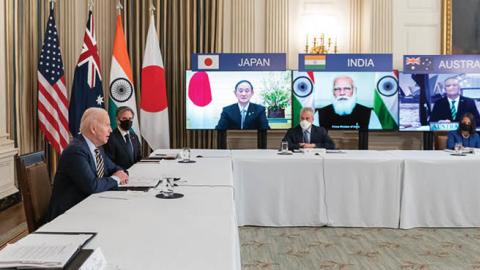As U.S. Vice President Kamala Harris confirmed in her recent call with Indian Prime Minister Narendra Modi, given that the coronavirus pandemic has receded in the United States, Washington can afford to send more vaccines and other aid abroad and India is at the top of the U.S. list. This is both a humane measure and smart policy: Indians have suffered tremendously throughout the pandemic, with a particularly lethal wave this spring driving the official death toll above 300,000; the unofficial toll is much higher. India is also an important partner for the United States and is one of the few countries that can act as an effective counterbalance to China and prevent Beijing from dominating Asia.
U.S. and Indian strategists have long recognized this confluence of interests and have worked to strengthen the bilateral relationship, but it has been a difficult process and is likely to remain so. Despite frequent references to the natural alliance between the world’s oldest democracy and the world’s largest, the ties between New Delhi and Washington are unlikely to ever rival the closeness of the Anglo-American special relationship. U.S. Secretary of State Antony Blinken, who lived in France during his childhood, may find Modi to be as important but difficult to work with as his predecessors found Charles de Gaulle. President Joe Biden can make significant progress with India, but to do so, he will have to set aside some of his other top priorities on Russia, trade, the environment, and maybe even human rights. If he does not, by the end of the year there will be a significant dust-up in Indian-American relations.
One of the most important obstacles that Biden and Modi will have to navigate is in the military sphere. The 2005 civil nuclear agreement was a diplomatic breakthrough that lifted American sanctions related to India’s nuclear program and made a strategic partnership possible. Since then, the U.S. has designated India a major defense partner, stepped up sales of military equipment, and negotiated agreements with India to facilitate military logistical and communications coordination. India and the United States form half of the Quad, which is becoming a vitally important network for managing Indo-Pacific affairs.
Despite these promising developments, there are storm clouds on the horizon. Although India was a founding member of the non-aligned movement, it maintained close ties with the Soviet Union during the Cold War and still has close ties with Russia today. In October 2019, India agreed to purchase Russia’s S-400 anti-aircraft missile system and is set to receive the first set of deliveries toward the end of this year. The Countering America’s Adversaries Through Sanctions Act (CAATSA) requires the U.S. to sanction India for this deal, as NATO member Turkey found out late last year when it was sanctioned. The Trump administration told India that it was unlikely to get a waiver from the law.
Will the Biden administration show more flexibility? Russian propaganda activities during the 2016 election made a tough Russia policy a high priority for Democrats, and Biden has already made significant concessions to Moscow by waiving sanctions on the Nord Stream 2 gas pipeline in Europe and extending the New START arms control agreement. Moreover, the S-400 delivery will add significant complications to India-U.S. military cooperation and will probably prevent India from acquiring top-shelf American aircraft such as the F-35. However, these difficulties are likely to be worse if the U.S. imposes sanctions, so Biden might have to waive the sanctions and accept a hard limit on joint operations as the cost of the Indian decision.
Taking a longer view, boosting the Indian economy is very important for the United States. The OECD recently projected that India’s GDP will be nearly 9 percent lower in 2025 than it was expected to be before the pandemic, and Bangladesh recently surpassed it in GDP per capita. A wealthier India is a stronger India, and more growth would make it better able to stand up to China.
A larger Indian economy would also provide Western companies and investors an alternative to China, but only if Biden and Modi can reach an agreement on trade restrictions. Modi’s “Atmanirbhar Bharat” call for self-reliance does not bode well for a trade deal, nor does India’s last-minute decision to withdraw from the Regional Comprehensive Economic Partnership (RCEP) trade pact, which left Japan alone as the only counter to China in the agreement. India is also altering investment rules that will hurt U.S. companies even more than an earlier 2018 rule change did. Earlier this month, the U.S. announced tariffs on India and other countries for their new taxes on American tech companies, but also a 180-day delay to allow for a negotiated settlement.
The most dramatic showdown may come before that deadline passes. The 26th United Nations Climate Change Conference of the Parties (COP26) will be held in the first half of November, and there could be fireworks in Glasgow between the U.S. and India. India is already the third-largest greenhouse gas emitter and its demand for energy will grow faster than any other country for the next two decades. It has accordingly ruled out a zero-emissions goal, which the energy minister has called “pie in the sky.” At Biden’s Earth Day summit, he and Modi announced a new green energy partnership, but Modi did not otherwise change any of the policies that are likely to lead to a 50 percent increase in emissions by 2040. If Modi holds firm in November, what will Biden do?
The military, economic, and climate policy controversies are already set on a fixed timeline, but tensions over democracy and human rights could flare up at any moment. While on the campaign trail, Biden expressed deep concerns about the Indian government’s treatment of its Muslim minority, particularly in Kashmir, as have prominent progressive Democrats like Senator Bernie Sanders. Muslims are not the only religious minority who could cause friction between U.S. human rights champions and the Hindu nationalist government, however: India has also cracked down on Christian organizations, such as the aid and development group Compassion International. If they intensify this activity, it could start to unsettle Christian leaders in the U.S., particularly Evangelicals who wield significant heft in the Republican Party. If New Delhi is not careful, it could break up the strong bipartisan support for the relationship (the Senate India Caucus has 31 members) and create instead a bipartisan opposition to closer ties.
Although many of the Indian elite speak English and the country shares with the United States a history of colonization by Great Britain, Washington has substantial disagreements with New Delhi that will be hard to manage. Nevertheless, the Biden administration has to get this right: India has the potential to be an important contributor to Asian security and prosperity, and this relationship is too valuable to lose.
Read in The Diplomat

















